From 1936 to 1955 there was only one television channel in the UK (and nothing at all during World War 2), then the ITV (Independent Television) network came along which unlike the BBC was funded entirely using revenue from advertisements shown between programmes. Another key difference with Independent Television (or ITV as it became known later) soon became apparent as the transmitter network expanded over the following years, namely that different companies were contracted to provide the television service for different regions of the British Isles, with the size and nature of those regions being determined by geographical factors (the availability of suitable transmitter sites) combined with technical considerations (frequency availability) and financial considerations determined by the population size that each transmitter served. Indeed, the three most populated regions of England (London, the Midlands and the North) were originally awarded separate broadcasting franchises for weekday and weekend broadcasting because it was felt that (for example) having one franchise serving millions of people in London seven days a week would lead to one franchise holder making much more money compared to other franchise holders and that company would end up dominating the network as a consequence.
 Having different TV broadcasting franchises for the second channel naturally resulted in different programmes being produced in different regions, though it soon became apparent that there was a requirement to share certain programming with other franchises due to cost considerations. Also many more programmes were broadcast live due to the high cost of film recording – video recording only became commercially available in 1957 and was also extremely expensive – therefore many programmes were broadcast simultaneously on different franchises at the same time, though certain franchises occasionally declined to show programming for various reason(s).
Having different TV broadcasting franchises for the second channel naturally resulted in different programmes being produced in different regions, though it soon became apparent that there was a requirement to share certain programming with other franchises due to cost considerations. Also many more programmes were broadcast live due to the high cost of film recording – video recording only became commercially available in 1957 and was also extremely expensive – therefore many programmes were broadcast simultaneously on different franchises at the same time, though certain franchises occasionally declined to show programming for various reason(s).
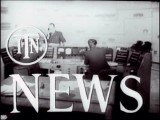 ITN (Independent Television News) provided news programmes for the ITV network and the organisation still does so today. The first bulletin was transmitted at 10pm on 22 September 1955 on ITV’s opening night, and introduced a less formal style of news broadcasting to the UK imported from America, which was in direct contrast to the cinema newsreels and still pictures that the BBC used. The appropriately-named Christopher Chataway presented the first programme, and him, along with Robin Day and Ludovic Kennedy, became household names.
ITN (Independent Television News) provided news programmes for the ITV network and the organisation still does so today. The first bulletin was transmitted at 10pm on 22 September 1955 on ITV’s opening night, and introduced a less formal style of news broadcasting to the UK imported from America, which was in direct contrast to the cinema newsreels and still pictures that the BBC used. The appropriately-named Christopher Chataway presented the first programme, and him, along with Robin Day and Ludovic Kennedy, became household names.
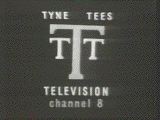 To begin with, independent television started life in London with Associated-Rediffusion providing the London weekday service plus ATV providing the London weekend service, but over the next few years the ITV network expanded with the addition of more regional franchises covering various parts of the United Kingdom. This caption from Tyne Tees (North-East England) gives the VHF channel number. Many TV sets produced before 1955 were often only capable of receiving one channel and these sets needed a “set-top convertor” to enable additional frequencies to be viewed.
To begin with, independent television started life in London with Associated-Rediffusion providing the London weekday service plus ATV providing the London weekend service, but over the next few years the ITV network expanded with the addition of more regional franchises covering various parts of the United Kingdom. This caption from Tyne Tees (North-East England) gives the VHF channel number. Many TV sets produced before 1955 were often only capable of receiving one channel and these sets needed a “set-top convertor” to enable additional frequencies to be viewed.
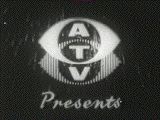 The news was not the only thing different about the new service. ITV, in contrast to the licence fee funded BBC, was more ‘downmarket’ in its approach, showing quiz games and popular light entertainment shows in order to attract viewers to the channel; many of these formats such as Associated-Rediffusion’s Double Your Money were imported from America. The caption shown here is the start of the title sequence for Sunday Night at the London Palladium, presented by Jack Parnell, and produced for the ITV network by Associated Television (ATV), which was the company that held the London ITV weekend franchise until 1968. ATV also held the Midlands ITV franchise (weekdays only until 1968) up to 1982 when ATV essentially reinvented itself as Central.
The news was not the only thing different about the new service. ITV, in contrast to the licence fee funded BBC, was more ‘downmarket’ in its approach, showing quiz games and popular light entertainment shows in order to attract viewers to the channel; many of these formats such as Associated-Rediffusion’s Double Your Money were imported from America. The caption shown here is the start of the title sequence for Sunday Night at the London Palladium, presented by Jack Parnell, and produced for the ITV network by Associated Television (ATV), which was the company that held the London ITV weekend franchise until 1968. ATV also held the Midlands ITV franchise (weekdays only until 1968) up to 1982 when ATV essentially reinvented itself as Central.
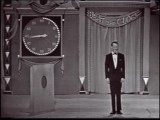 Sunday Night at the London Palladium was basically a traditional variety show format adapted for television, but it also featured what was the novel addition of a quiz show segment (Beat The Clock, shown here with Bruce Forsyth as the presenter). This entertainment mixture proved to be very popular for many years with audience figures often exceeding 20 million in its heyday, firmly establishing ITV as the home of popular entertainmentand the format has been revived on more than one occasion.
Sunday Night at the London Palladium was basically a traditional variety show format adapted for television, but it also featured what was the novel addition of a quiz show segment (Beat The Clock, shown here with Bruce Forsyth as the presenter). This entertainment mixture proved to be very popular for many years with audience figures often exceeding 20 million in its heyday, firmly establishing ITV as the home of popular entertainmentand the format has been revived on more than one occasion.
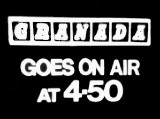 Granada Television was the third ITV franchise to launch in 1956, initially serving the North-West of England, Yorkshire and (unofficially) parts of North Wales, and over the years Granada outlived all the other franchises to form the modern ITV plc that it is today. The company started life as a chain of cinemas, entering the world of television rather reluctantly to begin with until its management was convinced of commercial television’s long term worth. Granada is famous for several programmes, especially Coronation Street (a long-running soap opera) and World in Action. (Photos above and below courtesy of Transdiffusion.)
Granada Television was the third ITV franchise to launch in 1956, initially serving the North-West of England, Yorkshire and (unofficially) parts of North Wales, and over the years Granada outlived all the other franchises to form the modern ITV plc that it is today. The company started life as a chain of cinemas, entering the world of television rather reluctantly to begin with until its management was convinced of commercial television’s long term worth. Granada is famous for several programmes, especially Coronation Street (a long-running soap opera) and World in Action. (Photos above and below courtesy of Transdiffusion.)
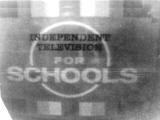 ITV started showing schools programmes as early as 13 May 1957, when Associated-Rediffusion (managed by the forward-thinking Paul Adorian) established the first regular schools broadcasting in the UK; the BBC following suit by September, initially showing one programme each afternoon. Many teachers were initially suspicious of using television as a teaching tool in the classroom, especially as they had to fit lessons around the showing of various programmes (not an easy task) with no means of recording them until the mid-1960s. Schools broadcasts also helped to lessen the perception that ITV consisted purely of mass market entertainment.
ITV started showing schools programmes as early as 13 May 1957, when Associated-Rediffusion (managed by the forward-thinking Paul Adorian) established the first regular schools broadcasting in the UK; the BBC following suit by September, initially showing one programme each afternoon. Many teachers were initially suspicious of using television as a teaching tool in the classroom, especially as they had to fit lessons around the showing of various programmes (not an easy task) with no means of recording them until the mid-1960s. Schools broadcasts also helped to lessen the perception that ITV consisted purely of mass market entertainment.
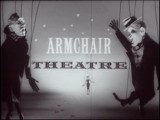 The ITV franchises may have produced ‘populist’ drama such as soap operas along with even more lightweight quiz and variety programming shown during the early evening, but ITV proved that there was a sizeable audience for more serious drama offerings such as the ABC-produced Armchair Theatre that featured one-off plays; indeed Armchair Theatre outlasted ABC and continued when Thames was formed for the London weekday ITV franchise in 1968.
The ITV franchises may have produced ‘populist’ drama such as soap operas along with even more lightweight quiz and variety programming shown during the early evening, but ITV proved that there was a sizeable audience for more serious drama offerings such as the ABC-produced Armchair Theatre that featured one-off plays; indeed Armchair Theatre outlasted ABC and continued when Thames was formed for the London weekday ITV franchise in 1968.
 The 1960s saw a further expansion of the ITV network, which finally enabled ITV programmes to be viewed in most parts of the country. Westward Television was arguably the first of the “second wave” of ITV franchises to start broadcasting in 1961, following on from the initial batch of franchises which had included Southern and Tyne Tees as well as the pioneers Associated-Rediffusion and Granada. At this point it seemed fairly obvious that ITV franchises were now capable of making money, though the first and only ITV company to go bankrupt whilst still holding a franchise (WWN) was soon to follow.
The 1960s saw a further expansion of the ITV network, which finally enabled ITV programmes to be viewed in most parts of the country. Westward Television was arguably the first of the “second wave” of ITV franchises to start broadcasting in 1961, following on from the initial batch of franchises which had included Southern and Tyne Tees as well as the pioneers Associated-Rediffusion and Granada. At this point it seemed fairly obvious that ITV franchises were now capable of making money, though the first and only ITV company to go bankrupt whilst still holding a franchise (WWN) was soon to follow.
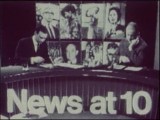 1967 saw the introduction of News at Ten, the half-hour news bulletin that became the cornerstone of the ITV schedule for over thirty years before being dropped in 1999 for a few years. ITN has always produced the news bulletins for the ITV network despite competition from other news providers in more recent times such as Sky News, and has also produced news bulletins for Channel 4 (and Channel 5 during its early years as well as nowadays).
1967 saw the introduction of News at Ten, the half-hour news bulletin that became the cornerstone of the ITV schedule for over thirty years before being dropped in 1999 for a few years. ITN has always produced the news bulletins for the ITV network despite competition from other news providers in more recent times such as Sky News, and has also produced news bulletins for Channel 4 (and Channel 5 during its early years as well as nowadays).
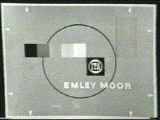 ITV’s Picasso Period…Up to the advent of colour in 1969 there was something called the ‘Picasso’ tuning signal, which was unofficially named after the famous artist by virtue of its style. (What Picasso himself would have made of it is unknown, but he surely would have given nodding approval.) The example pictured was broadcast exclusively from the Emley Moor transmitter in Yorkshire, with various other transmitters transmitting their own individual identifying captions that helped engineers and viewers to tune and adjust their receiving equipment. Old sets needed much more attention in this respect compared to their modern counterparts which are plug-and-play devices based around computers.
ITV’s Picasso Period…Up to the advent of colour in 1969 there was something called the ‘Picasso’ tuning signal, which was unofficially named after the famous artist by virtue of its style. (What Picasso himself would have made of it is unknown, but he surely would have given nodding approval.) The example pictured was broadcast exclusively from the Emley Moor transmitter in Yorkshire, with various other transmitters transmitting their own individual identifying captions that helped engineers and viewers to tune and adjust their receiving equipment. Old sets needed much more attention in this respect compared to their modern counterparts which are plug-and-play devices based around computers.
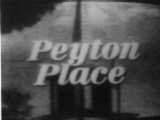 ITV’s first major shakeup caught almost everyone by surprise. The popular and respected ABC, whom prior to 1968 owned the (now extinct) Midlands and North of England weekend franchises had just expected to have been given one of the remaining major ITV franchises – London weekdays in particular being the coveted favourite – but being specifically asked to create a new ITV franchise company was a twist that nobody foresaw. Peyton Place was the very last programme to be transmitted by Rediffusion London in 1968 before the newly-created Thames Television took over as the London weekday franchise holder. ATV took over the Midlands franchise full-time with the weekend split being abolished.
ITV’s first major shakeup caught almost everyone by surprise. The popular and respected ABC, whom prior to 1968 owned the (now extinct) Midlands and North of England weekend franchises had just expected to have been given one of the remaining major ITV franchises – London weekdays in particular being the coveted favourite – but being specifically asked to create a new ITV franchise company was a twist that nobody foresaw. Peyton Place was the very last programme to be transmitted by Rediffusion London in 1968 before the newly-created Thames Television took over as the London weekday franchise holder. ATV took over the Midlands franchise full-time with the weekend split being abolished.
 Thames Television was created from the television production divisions of ABC (51%) and Rediffusion (49%) with ABC’s parent company ABPC being in overall control. With the new company structure, ABPC took the opportunity to change the ITV franchise name from ABC to Thames; a reason for doing this was that it would avoid confusion with the totally unrelated US and Australian ABC networks, especially when relating to international programme sales. After the creation of Thames, both the ABC and Rediffusion brands continued to be used for other purposes (cinemas and cable television to name but two) by their respective parent companies since only their ITV franchise operations had been affected.
Thames Television was created from the television production divisions of ABC (51%) and Rediffusion (49%) with ABC’s parent company ABPC being in overall control. With the new company structure, ABPC took the opportunity to change the ITV franchise name from ABC to Thames; a reason for doing this was that it would avoid confusion with the totally unrelated US and Australian ABC networks, especially when relating to international programme sales. After the creation of Thames, both the ABC and Rediffusion brands continued to be used for other purposes (cinemas and cable television to name but two) by their respective parent companies since only their ITV franchise operations had been affected.
 As well as the changes listed above, TWW (Television Wales and West) were ‘dispossessed’ and replaced by Harlech Television, a company named after Lord Harlech but which was soon to be renamed HTV since the Harlech name (rightly or wrongly to many viewers) reflected a Welsh bias to viewers in the West of England. The HTV franchise has since passed through the hands of UNM (United News and Media) and Carlton before Carlton was ‘merged’ with Granada to create what is now known as ITV Cymru Wales. Pre-programme company idents (as such) were no longer used from the beginning of 1988.
As well as the changes listed above, TWW (Television Wales and West) were ‘dispossessed’ and replaced by Harlech Television, a company named after Lord Harlech but which was soon to be renamed HTV since the Harlech name (rightly or wrongly to many viewers) reflected a Welsh bias to viewers in the West of England. The HTV franchise has since passed through the hands of UNM (United News and Media) and Carlton before Carlton was ‘merged’ with Granada to create what is now known as ITV Cymru Wales. Pre-programme company idents (as such) were no longer used from the beginning of 1988.
 World Of Sport was ITV’s famous Saturday afternoon sports programme presented by Dickie Davies which ran until 1985, and typically featured football (On The Ball), Australian rules football, stock car racing and the very popular wrestling matches that made household names of wrestlers such as Big Daddy, Giant Haystacks and Kendo Nagasaki, etc., as well as horse racing and other sports. Recently ITV revived the World of Sport brand for wrestling events and other purposes.
World Of Sport was ITV’s famous Saturday afternoon sports programme presented by Dickie Davies which ran until 1985, and typically featured football (On The Ball), Australian rules football, stock car racing and the very popular wrestling matches that made household names of wrestlers such as Big Daddy, Giant Haystacks and Kendo Nagasaki, etc., as well as horse racing and other sports. Recently ITV revived the World of Sport brand for wrestling events and other purposes.
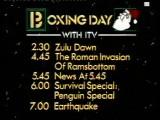 Various regional ITV companies became nationally well known for their contributions to the ITV network; for example Anglia became famous for its wildlife series Survival as well as its downmarket quiz Sale of the Century (“From Norwich, it’s the quiz of the week…”), Southern Television produced Out of Town presented by Jack Hargreaves, and the derestriction of ITV’s broadcasting hours in 1972 enabled Yorkshire Television to produce Emmerdale Farm which continues to this day as an evening soap just known as Emmerdale.
Various regional ITV companies became nationally well known for their contributions to the ITV network; for example Anglia became famous for its wildlife series Survival as well as its downmarket quiz Sale of the Century (“From Norwich, it’s the quiz of the week…”), Southern Television produced Out of Town presented by Jack Hargreaves, and the derestriction of ITV’s broadcasting hours in 1972 enabled Yorkshire Television to produce Emmerdale Farm which continues to this day as an evening soap just known as Emmerdale.
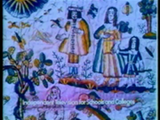
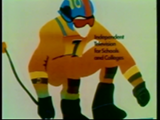

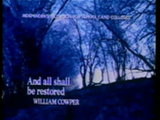
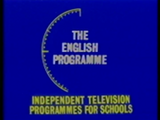 For many years, Independent Television for Schools and Colleges programming shown on ITV followed the same pattern, namely a picture was shown on screen accompanied by music, with the picture being replaced by a countdown clock with vanishing divisions showing for the final minute before the start of the programme.
For many years, Independent Television for Schools and Colleges programming shown on ITV followed the same pattern, namely a picture was shown on screen accompanied by music, with the picture being replaced by a countdown clock with vanishing divisions showing for the final minute before the start of the programme.
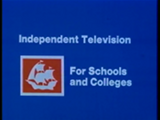 Schools programmes also enabled smaller ITV franchises like Border, Grampian and even Channel to fulfil their franchise requirements in terms of supplying networked ITV programmes. Various ITV schools programmes included A Place to Live, the ‘A’ Level chemistry programme Experiment, and arguably the most famous ITV schools programme of them all, How We Used To Live.
Schools programmes also enabled smaller ITV franchises like Border, Grampian and even Channel to fulfil their franchise requirements in terms of supplying networked ITV programmes. Various ITV schools programmes included A Place to Live, the ‘A’ Level chemistry programme Experiment, and arguably the most famous ITV schools programme of them all, How We Used To Live.
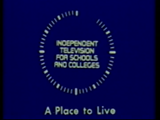 Here’s a later example of the Independent Television For Schools clock as used in the 1980s with a different clock face and font style. No commercials were shown before or during the programmes intended for schools and colleges, and this practice continued until ITV schools programming was moved to Channel 4 at the start of 1988.
Here’s a later example of the Independent Television For Schools clock as used in the 1980s with a different clock face and font style. No commercials were shown before or during the programmes intended for schools and colleges, and this practice continued until ITV schools programming was moved to Channel 4 at the start of 1988.
 The 1980s started with a degree of uncertainty for the ITV contractors, as the second franchise review took place. Three familiar ITV names – ATV, Southern and Westward – were displaced by newcomers Central Independent Television, TVS (Television South) and TSW (Television South West) on January 1 1982, with one surprise being the loss of ATV because they were still a very successful ITV franchise holder, though Central were in essence just a ‘reorganised ATV’ with greater local commitments forced upon it by the Independent Broadcasting Authority (IBA). With improved local provisioning in mind, another change were made to the South East with the Bluebell Hill transmitter in Kent broadcasting TVS (which had pledged to improve the South-East of England’s local news service from new regional studios at Maidstone) instead of Thames/LWT.
The 1980s started with a degree of uncertainty for the ITV contractors, as the second franchise review took place. Three familiar ITV names – ATV, Southern and Westward – were displaced by newcomers Central Independent Television, TVS (Television South) and TSW (Television South West) on January 1 1982, with one surprise being the loss of ATV because they were still a very successful ITV franchise holder, though Central were in essence just a ‘reorganised ATV’ with greater local commitments forced upon it by the Independent Broadcasting Authority (IBA). With improved local provisioning in mind, another change were made to the South East with the Bluebell Hill transmitter in Kent broadcasting TVS (which had pledged to improve the South-East of England’s local news service from new regional studios at Maidstone) instead of Thames/LWT.
 Also ITV gained a new national breakfast television service provided by a completely separate contractor – TV-am, which began broadcasting a little more than a year after the other changes (1 February 1983), going on-air shortly after the BBC had launched its own ‘spoiler’ Breakfast Time programme on BBC1.
Also ITV gained a new national breakfast television service provided by a completely separate contractor – TV-am, which began broadcasting a little more than a year after the other changes (1 February 1983), going on-air shortly after the BBC had launched its own ‘spoiler’ Breakfast Time programme on BBC1.
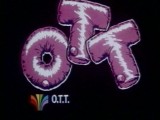 New franchises, new ideas…With three new ITV franchises wanting to attract and keep their viewers, there was an outburst of creativity on the ITV network over the next two or so years, though the end results were perhaps understandably mixed, with Central having the most luck network-wise and TSW getting the wooden spoon prize for (not) getting their shows on-air nationally. Central replaced Pipkins with Let’s Pretend and launched O.T.T.; an adult version of Tiswas which had little difficulty in attracting viewers but controversy forced it off-air after only one series.
New franchises, new ideas…With three new ITV franchises wanting to attract and keep their viewers, there was an outburst of creativity on the ITV network over the next two or so years, though the end results were perhaps understandably mixed, with Central having the most luck network-wise and TSW getting the wooden spoon prize for (not) getting their shows on-air nationally. Central replaced Pipkins with Let’s Pretend and launched O.T.T.; an adult version of Tiswas which had little difficulty in attracting viewers but controversy forced it off-air after only one series.
 Rather more successful shows produced by Central during its first few years included Auf Wiedersehen, Pet, which proved to be very popular and so were quizzes such as Bullseye and The Price Is Right; ATV’s Crossroads soap continued but was axed in 1988, and so did the drama Boon. In 1984 the popular satirical puppet comedy Spitting Image made its debut, though its first series featured a studio audience (an idea that was subsequently dropped).
Rather more successful shows produced by Central during its first few years included Auf Wiedersehen, Pet, which proved to be very popular and so were quizzes such as Bullseye and The Price Is Right; ATV’s Crossroads soap continued but was axed in 1988, and so did the drama Boon. In 1984 the popular satirical puppet comedy Spitting Image made its debut, though its first series featured a studio audience (an idea that was subsequently dropped).
 Being a significant newcomer to the ITV network, TVS came up with some new ideas of its own including detective drama C.A.T.S. Eyes, science series The Real World which featured ex-Tomorrow’s World presenter Michael Rodd and featured a 3D TV experiment with free coloured lens glasses supplied with copies of the TV Times; TVS also produced kids’ TV offerings On Safari and the Saturday morning show No 73. The only programmes that TSW managed to make an impact with on ITV were basically the quiz show Sounds Like Music, daytime canine competition That’s My Dog which also had the distinction of being the first ITV programme to have a commercial sponsor (Pedigree Chum dog food), plus the children’s cartoon series Tube Mice.
Being a significant newcomer to the ITV network, TVS came up with some new ideas of its own including detective drama C.A.T.S. Eyes, science series The Real World which featured ex-Tomorrow’s World presenter Michael Rodd and featured a 3D TV experiment with free coloured lens glasses supplied with copies of the TV Times; TVS also produced kids’ TV offerings On Safari and the Saturday morning show No 73. The only programmes that TSW managed to make an impact with on ITV were basically the quiz show Sounds Like Music, daytime canine competition That’s My Dog which also had the distinction of being the first ITV programme to have a commercial sponsor (Pedigree Chum dog food), plus the children’s cartoon series Tube Mice.
 Existing ITV franchises also launched new programming such as Yorkshire Television’s science show Where There’s Life, Thames Television’s Button Moon for young children, and Granada produced The Adventures of Sherlock Holmes and the hugely successful drama series The Jewel in the Crown in 1984, so ITV was still proving that it could be a force to be reckoned with despite all its recent upheavals. And 1985 saw the launch of long-running dating game show Blind Date, produced by LWT and presented for many years by Cilla Black.
Existing ITV franchises also launched new programming such as Yorkshire Television’s science show Where There’s Life, Thames Television’s Button Moon for young children, and Granada produced The Adventures of Sherlock Holmes and the hugely successful drama series The Jewel in the Crown in 1984, so ITV was still proving that it could be a force to be reckoned with despite all its recent upheavals. And 1985 saw the launch of long-running dating game show Blind Date, produced by LWT and presented for many years by Cilla Black.
 ITV continued to prosper during the second half of the 1980s as the new franchises bedded in, and the established ITV players continued apace; Granada adapted the novel First Among Equals into a 10-part drama series shown in 1986, and Thames’ long-running Strike It Lucky (later renamed Strike It Rich) quiz hosted by Michael Barrymore started in October of the same year. In 1988 Thames produced a highly controversial edition of current affairs programme This Week entitled Death on the Rock which some claim was a significant factor in Thames subsequently losing its ITV franchise even though this was officially denied; the same year also saw the launch of long-running drama series London’s Burning. Despite these successes there were clouds on the horizon for the ITV franchises in general; new technology such as the introduction of satellite television and the rapid growth of cable television networks meant theoretical new direct competition for ITV’s prized ad revenue – could ITV’s long-held “licence to print money” be finally coming to an end?
ITV continued to prosper during the second half of the 1980s as the new franchises bedded in, and the established ITV players continued apace; Granada adapted the novel First Among Equals into a 10-part drama series shown in 1986, and Thames’ long-running Strike It Lucky (later renamed Strike It Rich) quiz hosted by Michael Barrymore started in October of the same year. In 1988 Thames produced a highly controversial edition of current affairs programme This Week entitled Death on the Rock which some claim was a significant factor in Thames subsequently losing its ITV franchise even though this was officially denied; the same year also saw the launch of long-running drama series London’s Burning. Despite these successes there were clouds on the horizon for the ITV franchises in general; new technology such as the introduction of satellite television and the rapid growth of cable television networks meant theoretical new direct competition for ITV’s prized ad revenue – could ITV’s long-held “licence to print money” be finally coming to an end?
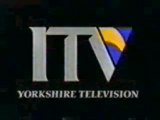 With the launch of Sky satellite TV in 1989 (and rival BSB soon to follow), some people at ITV thought that it would be opportune to create a more unified appearance for a TV channel that essentially comprised of a collection of separate regional TV broadcast franchises which happened to share much of their programming, hence the English Marshall Pockett agency were commissioned to produce a new identity package for ITV featuring a new logo plus generic-looking idents (within each ident, the ‘V’ of ITV showed part of the regional company logo), and other presentational elements intended to be used right across the ITV network, with a new theme tune composed by Lord David Dundas (also the composer of the original Channel 4 theme 4 Score). However not all of the ITV franchises adopted this new look, with the Channel, LWT and TVS franchises totally ignoring it from a local perspective, plus nearly all of the ITV franchises that did use the generic package ended up abandoning its use after only a year, with the notable exception of Grampian Television who continued to use their ITV generic ident right up until 2006 and the STV takeover.
With the launch of Sky satellite TV in 1989 (and rival BSB soon to follow), some people at ITV thought that it would be opportune to create a more unified appearance for a TV channel that essentially comprised of a collection of separate regional TV broadcast franchises which happened to share much of their programming, hence the English Marshall Pockett agency were commissioned to produce a new identity package for ITV featuring a new logo plus generic-looking idents (within each ident, the ‘V’ of ITV showed part of the regional company logo), and other presentational elements intended to be used right across the ITV network, with a new theme tune composed by Lord David Dundas (also the composer of the original Channel 4 theme 4 Score). However not all of the ITV franchises adopted this new look, with the Channel, LWT and TVS franchises totally ignoring it from a local perspective, plus nearly all of the ITV franchises that did use the generic package ended up abandoning its use after only a year, with the notable exception of Grampian Television who continued to use their ITV generic ident right up until 2006 and the STV takeover.
 Prior to the post-2002 ITV franchise consolidation process, there were many more companies owning various individual ITV franchises that permitted them to broadcast to individual regions, and these franchises are reviewed every couple of years, with licence renewal not being an automatic process at this point, as many companies subsequently found to their cost. Thames, TVS, TSW and TV-am all lost their franchises and were replaced by Carlton, Meridian, Westcountry and GMTV at the start of 1993. The manner of which the franchise renewals were conducted in 1991 was highly controversial, and Thames Television losing its London franchise was certainly a point of huge contention. ITV programmes produced during this period included Yorkshire Television’s highly successful comedy drama adaptation of H.E.Bates’ novels entitled The Darling Buds of May.
Prior to the post-2002 ITV franchise consolidation process, there were many more companies owning various individual ITV franchises that permitted them to broadcast to individual regions, and these franchises are reviewed every couple of years, with licence renewal not being an automatic process at this point, as many companies subsequently found to their cost. Thames, TVS, TSW and TV-am all lost their franchises and were replaced by Carlton, Meridian, Westcountry and GMTV at the start of 1993. The manner of which the franchise renewals were conducted in 1991 was highly controversial, and Thames Television losing its London franchise was certainly a point of huge contention. ITV programmes produced during this period included Yorkshire Television’s highly successful comedy drama adaptation of H.E.Bates’ novels entitled The Darling Buds of May.
 Commercial television sometimes uses what is known as a ‘break bumper’ which is a very short (typically less than 2 second) animation with no music shown just before and/or after the commercial break – the picture is taken from one which was used by Meridian Television. Occasionally ITV companies used a simple animation between each commercial as well (technically known as an ‘optic’ or ‘ad spacer’); the one used by Westward Television featured a rotating hexagon of all things, something perhaps adopted with Channel Television in mind because for many years Westward provided the ‘parent’ programme feed for the smallest ITV contractor serving the Channel Islands.
Commercial television sometimes uses what is known as a ‘break bumper’ which is a very short (typically less than 2 second) animation with no music shown just before and/or after the commercial break – the picture is taken from one which was used by Meridian Television. Occasionally ITV companies used a simple animation between each commercial as well (technically known as an ‘optic’ or ‘ad spacer’); the one used by Westward Television featured a rotating hexagon of all things, something perhaps adopted with Channel Television in mind because for many years Westward provided the ‘parent’ programme feed for the smallest ITV contractor serving the Channel Islands.
 With the new ITV franchise holders came new early evening regional news programmes in their respective regions: for example, Carlton introduced London Tonight, Meridian introduced Meridian Tonight (replacing TVS’s Coast to Coast) whilst Westcountry introduced Westcountry Live as a replacement for TSW Today.
With the new ITV franchise holders came new early evening regional news programmes in their respective regions: for example, Carlton introduced London Tonight, Meridian introduced Meridian Tonight (replacing TVS’s Coast to Coast) whilst Westcountry introduced Westcountry Live as a replacement for TSW Today.
 TV from the heart…ITV’s new image as introduced on 5 October 1998, which includes a new lower case itv logo (replacing the 1989 design) and colour scheme. Designed by English and Pockett, the theme of hearts introduced throughout ITV’s on-screen presentation is meant to symbolise ‘warmth’ and ‘cuddliness’, though presumably ITV executives nearly had heart failure when they learnt of the BBC Choice ‘three hearts’ ident that also introduced during 1998. However not all companies made use all the changes, eg. Meridian and others frequently used their own style of ident/break bumper and appended their own logo to generic ITV trailers. LWT for some reason decided to create their own idents based around the hearts theme, perhaps to make their own output a bit more distinctive compared to Carlton’s weekday presentation. 1998 also saw the beginning of a successful long-running big money quiz: Who Wants To Be A Millionaire?.
TV from the heart…ITV’s new image as introduced on 5 October 1998, which includes a new lower case itv logo (replacing the 1989 design) and colour scheme. Designed by English and Pockett, the theme of hearts introduced throughout ITV’s on-screen presentation is meant to symbolise ‘warmth’ and ‘cuddliness’, though presumably ITV executives nearly had heart failure when they learnt of the BBC Choice ‘three hearts’ ident that also introduced during 1998. However not all companies made use all the changes, eg. Meridian and others frequently used their own style of ident/break bumper and appended their own logo to generic ITV trailers. LWT for some reason decided to create their own idents based around the hearts theme, perhaps to make their own output a bit more distinctive compared to Carlton’s weekday presentation. 1998 also saw the beginning of a successful long-running big money quiz: Who Wants To Be A Millionaire?.
 The next (and not uncontroversial) change was the axing of News at Ten from March 8 1999. Since 1967, News at Ten had been a regular feature of the ITV weekday evening schedule and it had also been a condition of the ITV franchise holders that they were to show it regardless, meaning that it was impossible to start showing a movie at (say) 9 pm without being interrupted by anything but commercials. After many complaints, the ITC forced ITV to reinstate its 10pm bulletin at least for four days a week; it was known as the “ITV News at Ten“, though it wasn’t too long before this idea was abandoned for a shorter bulletin in a later slot. Nowadays both ITV and BBC One have major news bulletins at 10pm.
The next (and not uncontroversial) change was the axing of News at Ten from March 8 1999. Since 1967, News at Ten had been a regular feature of the ITV weekday evening schedule and it had also been a condition of the ITV franchise holders that they were to show it regardless, meaning that it was impossible to start showing a movie at (say) 9 pm without being interrupted by anything but commercials. After many complaints, the ITC forced ITV to reinstate its 10pm bulletin at least for four days a week; it was known as the “ITV News at Ten“, though it wasn’t too long before this idea was abandoned for a shorter bulletin in a later slot. Nowadays both ITV and BBC One have major news bulletins at 10pm.
 From Monday 8 November 1999 – a year and a month after the ITV ‘heart’ logo was introduced, all English ITV franchises (except the Carlton-owned regions) adopted the ITV “generic” look for their on-screen presentation. The Carlton example is taken from the Midlands (Central) region which used orange as a background colour.
From Monday 8 November 1999 – a year and a month after the ITV ‘heart’ logo was introduced, all English ITV franchises (except the Carlton-owned regions) adopted the ITV “generic” look for their on-screen presentation. The Carlton example is taken from the Midlands (Central) region which used orange as a background colour.
 Behind the scenes at ITV there have been many upheavals within many of the franchises since the mid 1990s with numerous mergers and acquistions; the net result by 2000 being that Granada owned all English ITV regions apart from London weekdays, the Midlands and the HTV West/South West of England (Westcountry) which were owned by Carlton, but even that was going to change by 2004 when Granada finally ‘merged’ with Carlton to create one company holding what were still several individual ITV franchises until the Digital Economy Act abolished them in 2010. Nowadays ITV owns all of the former franchise regions (including UTV and Channel) apart from STV covering the whole of Scotland.
Behind the scenes at ITV there have been many upheavals within many of the franchises since the mid 1990s with numerous mergers and acquistions; the net result by 2000 being that Granada owned all English ITV regions apart from London weekdays, the Midlands and the HTV West/South West of England (Westcountry) which were owned by Carlton, but even that was going to change by 2004 when Granada finally ‘merged’ with Carlton to create one company holding what were still several individual ITV franchises until the Digital Economy Act abolished them in 2010. Nowadays ITV owns all of the former franchise regions (including UTV and Channel) apart from STV covering the whole of Scotland.
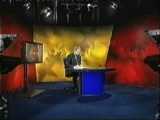 The studio set of the early evening regional news programme Central News at Six (shown here) demonstrates how the star theme used by Carlton had been utilised (note the star pattern on the backdrop of the news studio). Nowadays all the English ITV regions use the same style of general presentation, with virtually identical studio sets employed throughout the regions. (Furthermore, some former regions have now been merged with each other, for example Yorkshire and Tyne Tees.)
The studio set of the early evening regional news programme Central News at Six (shown here) demonstrates how the star theme used by Carlton had been utilised (note the star pattern on the backdrop of the news studio). Nowadays all the English ITV regions use the same style of general presentation, with virtually identical studio sets employed throughout the regions. (Furthermore, some former regions have now been merged with each other, for example Yorkshire and Tyne Tees.)
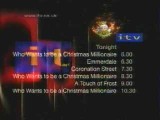 This ‘programme menu’ shows the lineup of programmes for ITV for Christmas Day 1999, which is dominated by a selection of programmes designed to try and attract the largest popular audience possible. ITV has in recent years performed relatively poorly in terms of audience share on Christmas Day, so this illustrates a clear attempt to reverse the trend, despite advertisers being less bothered about advertising on Christmas Day in spite of a potentially large captive audience.
This ‘programme menu’ shows the lineup of programmes for ITV for Christmas Day 1999, which is dominated by a selection of programmes designed to try and attract the largest popular audience possible. ITV has in recent years performed relatively poorly in terms of audience share on Christmas Day, so this illustrates a clear attempt to reverse the trend, despite advertisers being less bothered about advertising on Christmas Day in spite of a potentially large captive audience.
 This picture illustrates something that is starting to become more commonplace during 2001 on both ITV and BBC One; notably End Credit Promotions (or ECP for short). Whilst the end credits of one programme are being shown (in this case for an episode of the ill-fated revival of Crossroads) in one part of the screen, a promotion for another programme is being shown at the same time.
This picture illustrates something that is starting to become more commonplace during 2001 on both ITV and BBC One; notably End Credit Promotions (or ECP for short). Whilst the end credits of one programme are being shown (in this case for an episode of the ill-fated revival of Crossroads) in one part of the screen, a promotion for another programme is being shown at the same time.
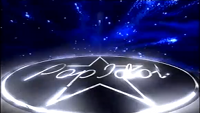 2001 saw the introduction of the first of a succession of big money-making light entertainment formats for ITV with Pop Idol; a singing contest featuring a hitherto novel combination of premium rate interactivity features (phone voting) and reality TV elements (namely, getting to know the contestants personally). This formula was subsequently adjusted by show producer Simon Cowell for the launch of The X Factor in April 2004, replacing Pop Idol in the UK, although the Pop Idol format continues to be used in certain other countries. A more traditional form of peak time weekend entertainment launched in June 2002 on ITV, namely Ant & Dec’s Saturday Night Takeaway.
2001 saw the introduction of the first of a succession of big money-making light entertainment formats for ITV with Pop Idol; a singing contest featuring a hitherto novel combination of premium rate interactivity features (phone voting) and reality TV elements (namely, getting to know the contestants personally). This formula was subsequently adjusted by show producer Simon Cowell for the launch of The X Factor in April 2004, replacing Pop Idol in the UK, although the Pop Idol format continues to be used in certain other countries. A more traditional form of peak time weekend entertainment launched in June 2002 on ITV, namely Ant & Dec’s Saturday Night Takeaway.
 October 2002 saw ITV1 launch a new look as part of a concerted effort to restore its image. ITV’s audience had been in steady decline over the last few years whilst (amongst other things) it concentrated efforts on the failed ONdigital/ITV Digital project. The new look featured various ITV personalities (such as Ant and Dec, pictured here) appearing before programmes, showing them as being “off duty” as part of short sequences, though an even more fundamental change at this point was that regional names such as Granada and Meridian were no longer used except for local news bulletins and sometimes seen just before regional programmes, plus some of these names were abandoned altogether at this juncture, eg. ITV1 London is used seven days a week with the LWT brand dropped (although the London region was at this point still controlled by two companies with Granada operating at the weekend and Carlton during weekdays).
October 2002 saw ITV1 launch a new look as part of a concerted effort to restore its image. ITV’s audience had been in steady decline over the last few years whilst (amongst other things) it concentrated efforts on the failed ONdigital/ITV Digital project. The new look featured various ITV personalities (such as Ant and Dec, pictured here) appearing before programmes, showing them as being “off duty” as part of short sequences, though an even more fundamental change at this point was that regional names such as Granada and Meridian were no longer used except for local news bulletins and sometimes seen just before regional programmes, plus some of these names were abandoned altogether at this juncture, eg. ITV1 London is used seven days a week with the LWT brand dropped (although the London region was at this point still controlled by two companies with Granada operating at the weekend and Carlton during weekdays).
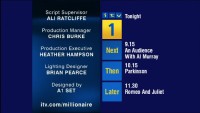 The final transformation: On 2 February 2004 Granada finally merged with Carlton to create one ITV company (“ITV plc”) for England and Wales when shares in the unified company were first traded on the Stock Exchange, though STV (Scottish/Grampian, formerly SMG) and UTV (Northern Ireland) remain separate entities at the time of writing. (Channel Television remained independent until 2010 when it was taken over by ITV plc.) The Granada name was adopted as the network production brand for a while, whilst the Carlton name promptly disappeared into the history books like so many of its ITV franchise predecessors, though the Granada brand nowadays only exists in the North-West of England as part of the title of the regional news magazine programme Granada Reports; the fate of several of the previous ITV franchise brands.
The final transformation: On 2 February 2004 Granada finally merged with Carlton to create one ITV company (“ITV plc”) for England and Wales when shares in the unified company were first traded on the Stock Exchange, though STV (Scottish/Grampian, formerly SMG) and UTV (Northern Ireland) remain separate entities at the time of writing. (Channel Television remained independent until 2010 when it was taken over by ITV plc.) The Granada name was adopted as the network production brand for a while, whilst the Carlton name promptly disappeared into the history books like so many of its ITV franchise predecessors, though the Granada brand nowadays only exists in the North-West of England as part of the title of the regional news magazine programme Granada Reports; the fate of several of the previous ITV franchise brands.
 A new unified look was introduced for ITV1 and ITV2, with ITV3 being created soon afterwards when Granada bought out BSkyB’s share of the digital channel (Granada). ITV4 was subsequently launched in 2005 with a new style of ITV logo that would be adopted elsewhere during 2006; the original plan was to scrap the Men & Motors channel but its continued popularity led to a reprieve and the ITV News Channel ended up being scrapped instead ostensibly due to the popularity of “on-demand” news (the ITV News Channel closed on 23 December 2005).
A new unified look was introduced for ITV1 and ITV2, with ITV3 being created soon afterwards when Granada bought out BSkyB’s share of the digital channel (Granada). ITV4 was subsequently launched in 2005 with a new style of ITV logo that would be adopted elsewhere during 2006; the original plan was to scrap the Men & Motors channel but its continued popularity led to a reprieve and the ITV News Channel ended up being scrapped instead ostensibly due to the popularity of “on-demand” news (the ITV News Channel closed on 23 December 2005).
 ITV suffered more than most from the decline in viewers experienced by nearly all television channels from the late-1990s onward, which was caused by numerous factors including most notably a large increase in the number of channels available via the uptake of digital television. With advertising revenues and market share still suffering from double-digit declines, ITV introduced a completely new look for its channels along with a new ‘itv’ logo in an attempt to reverse its declining fortunes, though it was (and still is) the most popular commercial television channel in the UK by a fair margin.
ITV suffered more than most from the decline in viewers experienced by nearly all television channels from the late-1990s onward, which was caused by numerous factors including most notably a large increase in the number of channels available via the uptake of digital television. With advertising revenues and market share still suffering from double-digit declines, ITV introduced a completely new look for its channels along with a new ‘itv’ logo in an attempt to reverse its declining fortunes, though it was (and still is) the most popular commercial television channel in the UK by a fair margin.
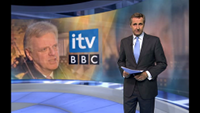 At this point, what ITV really needed was a manager with a proven track record within the media industry as well as being deeply familiar with the history of ITV and its inner workings as a programme maker. Step forward Michael Grade, who was convinced of a need to return to his old employer in order to revive its flagging fortunes, even if his return to ITV in November 2006 was going to be relatively short-lived. Indeed Grade left the BBC at what seemed to be a critical point during licence fee negotiations which had taken place in conjunction with Mark Thompson, so this move was rather surprising yet welcome for ITV, all things considered. Whatever your views on Grade, his name gave some much-needed reassurance to ITV’s shareholders at an important juncture.
At this point, what ITV really needed was a manager with a proven track record within the media industry as well as being deeply familiar with the history of ITV and its inner workings as a programme maker. Step forward Michael Grade, who was convinced of a need to return to his old employer in order to revive its flagging fortunes, even if his return to ITV in November 2006 was going to be relatively short-lived. Indeed Grade left the BBC at what seemed to be a critical point during licence fee negotiations which had taken place in conjunction with Mark Thompson, so this move was rather surprising yet welcome for ITV, all things considered. Whatever your views on Grade, his name gave some much-needed reassurance to ITV’s shareholders at an important juncture.
 This caption illustrates the style of end credit promotion used by ITV around this time, showing what is coming up next on various other ITV channels. Note the mention of a (short-lived) ITV Play channel, which was forced to close due to industry-wide concerns over the use of premium rate phone lines for viewers to call in order to answer quiz questions. ITV Nightscreen still continues to be shown at various times during the early morning.
This caption illustrates the style of end credit promotion used by ITV around this time, showing what is coming up next on various other ITV channels. Note the mention of a (short-lived) ITV Play channel, which was forced to close due to industry-wide concerns over the use of premium rate phone lines for viewers to call in order to answer quiz questions. ITV Nightscreen still continues to be shown at various times during the early morning.
 ITV formally launched a high definition version of ITV1 on 2 April 2010 with six regional variations, and is available on Freeview HD unlike the high definition versions of other ITV channels due to a lack of available bandwidth, though not all new programmes were produced in HD at the time. ITV HD initially launched as a trial channel to Telewest cable TV customers in 2006 as well as being a limited experimental terrestrial broadcast in the London area from Crystal Palace, and was launched primarily for the showing of World Cup games as well as other programming such as films, Poirot, and a remastered version of the 70s sci-fi epic Space: 1999. 2009 saw the ITV HD channel appear on Freesat and Freeview HD (rebranded ITV1 HD), but the HD service was still limited to the hours of 18:00-23:00 7 days a week until the official launch; the same year also saw the demise of long-running arts series The South Bank Show in December, an occasion seen by some as the death of serious factual programming on the channel.
ITV formally launched a high definition version of ITV1 on 2 April 2010 with six regional variations, and is available on Freeview HD unlike the high definition versions of other ITV channels due to a lack of available bandwidth, though not all new programmes were produced in HD at the time. ITV HD initially launched as a trial channel to Telewest cable TV customers in 2006 as well as being a limited experimental terrestrial broadcast in the London area from Crystal Palace, and was launched primarily for the showing of World Cup games as well as other programming such as films, Poirot, and a remastered version of the 70s sci-fi epic Space: 1999. 2009 saw the ITV HD channel appear on Freesat and Freeview HD (rebranded ITV1 HD), but the HD service was still limited to the hours of 18:00-23:00 7 days a week until the official launch; the same year also saw the demise of long-running arts series The South Bank Show in December, an occasion seen by some as the death of serious factual programming on the channel.
 A long-running institution came to an end on 31 August 2010 with the final episode of The Bill (Part 2 of a story entitled ‘Respect’). Produced by Thames Television, it started life as a one-off drama entitled ‘Woodentop‘ in 1984 which then got turned into a series, and its cast rapidly became household names as the series increased in popularity. The Bill went through several changes throughout its lifetime, including the controversial adoption of soap opera-style storylines (along with several cast changes), alienating many of the drama’s core fans before reverting back to predominantly self-contained stories using a regular cast as had been the case from the beginning. It has been claimed that the final nail in the coffin for this series came with an abrupt move to a post-9pm timeslot with barely enough notice given so as to modify existing stories for the extended hour-long slot, hence the end result proved to be relatively unsuitable despite some strong storylines.
A long-running institution came to an end on 31 August 2010 with the final episode of The Bill (Part 2 of a story entitled ‘Respect’). Produced by Thames Television, it started life as a one-off drama entitled ‘Woodentop‘ in 1984 which then got turned into a series, and its cast rapidly became household names as the series increased in popularity. The Bill went through several changes throughout its lifetime, including the controversial adoption of soap opera-style storylines (along with several cast changes), alienating many of the drama’s core fans before reverting back to predominantly self-contained stories using a regular cast as had been the case from the beginning. It has been claimed that the final nail in the coffin for this series came with an abrupt move to a post-9pm timeslot with barely enough notice given so as to modify existing stories for the extended hour-long slot, hence the end result proved to be relatively unsuitable despite some strong storylines.
 When ITV had an opportunity to acquire the independent Channel 3 breakfast TV franchise held by GMTV by buying out Disney’s share of the company it did so, and a new breakfast show was soon created for ITV1 – Daybreak, which launched on 6 September 2010 and isn’t to be confused with a programme of the same name broadcast by the TV-am franchise. (The breakfast television franchise remained classed as a separate entity within the 2010 Digital Economy Act passed within the last weeks of Gordon Brown’s Labour administration.)
When ITV had an opportunity to acquire the independent Channel 3 breakfast TV franchise held by GMTV by buying out Disney’s share of the company it did so, and a new breakfast show was soon created for ITV1 – Daybreak, which launched on 6 September 2010 and isn’t to be confused with a programme of the same name broadcast by the TV-am franchise. (The breakfast television franchise remained classed as a separate entity within the 2010 Digital Economy Act passed within the last weeks of Gordon Brown’s Labour administration.)
 Poaching Adrian Chiles and Christine Bleakley from the BBC was supposedly going to be a ‘safe’ option in an attempt to somehow transplant the popularity of BBC One’s The One Show into breakfast time television, but by doing so ended up alienating loyal GMTV viewers who had become accustomed to its cosy charms, and just as GMTV had slowly evolved to become more like its TV-am predecessor, Daybreak soon made changes to its format in order to become a little more like its GMTV predecessor, though BBC One’s rival Breakfast News continued to outperform Daybreak in terms of popularity and Daybreak‘s sinking fortunes caused ITV to have yet another rethink and yet another borrowing from the past with the launch of Good Morning Britain in April 2014 (sharing a title with TV-am’s original breakfast time show).
Poaching Adrian Chiles and Christine Bleakley from the BBC was supposedly going to be a ‘safe’ option in an attempt to somehow transplant the popularity of BBC One’s The One Show into breakfast time television, but by doing so ended up alienating loyal GMTV viewers who had become accustomed to its cosy charms, and just as GMTV had slowly evolved to become more like its TV-am predecessor, Daybreak soon made changes to its format in order to become a little more like its GMTV predecessor, though BBC One’s rival Breakfast News continued to outperform Daybreak in terms of popularity and Daybreak‘s sinking fortunes caused ITV to have yet another rethink and yet another borrowing from the past with the launch of Good Morning Britain in April 2014 (sharing a title with TV-am’s original breakfast time show).
 January 2013 saw ITV’s biggest identity and corporate rebrand in 12 years, and a brand new curvy and joined-up lowercase logo was just one of several changes. Gone was the designation of ITV1 for the most popular channel; it’s now just known as ITV because that’s how most viewers refer to it (apparently). In theory doing such a thing might make distinguishing between ITV the broadcaster and ITV the channel a little tricky, but ITV has basically copied Channel 4 in this respect. All ITV channels had a simultaneous presentational makeover; the ITV channel gaining several new idents where the different colours of the logo change as the ident progresses, with the logo only becoming fully-formed at various points, taking a cue from the nature of Channel 4’s acclaimed idents on this occasion.
January 2013 saw ITV’s biggest identity and corporate rebrand in 12 years, and a brand new curvy and joined-up lowercase logo was just one of several changes. Gone was the designation of ITV1 for the most popular channel; it’s now just known as ITV because that’s how most viewers refer to it (apparently). In theory doing such a thing might make distinguishing between ITV the broadcaster and ITV the channel a little tricky, but ITV has basically copied Channel 4 in this respect. All ITV channels had a simultaneous presentational makeover; the ITV channel gaining several new idents where the different colours of the logo change as the ident progresses, with the logo only becoming fully-formed at various points, taking a cue from the nature of Channel 4’s acclaimed idents on this occasion.
 Unsurprisingly ITV News also received a makeover at the same time, with a more sober single colour treatment of the logo and a very contemporary feel applied to the studio with a designer combination of creamy white, navy blue and a wooden floor. All the regional news studios were updated similarly, and the colour scheme also applies to the graphics and associated promotional material. As of 2013, ITV’s programme portfolio includes the acclaimed period drama Downton Abbey, recently-introduced period drama Mr Selfridge, and the new Saturday evening entertainment show Splash! that features celebrities diving into a pool, though the early evening cookery contest Food Glorious Food! turned out to be less appetising to viewers than originally expected.
Unsurprisingly ITV News also received a makeover at the same time, with a more sober single colour treatment of the logo and a very contemporary feel applied to the studio with a designer combination of creamy white, navy blue and a wooden floor. All the regional news studios were updated similarly, and the colour scheme also applies to the graphics and associated promotional material. As of 2013, ITV’s programme portfolio includes the acclaimed period drama Downton Abbey, recently-introduced period drama Mr Selfridge, and the new Saturday evening entertainment show Splash! that features celebrities diving into a pool, though the early evening cookery contest Food Glorious Food! turned out to be less appetising to viewers than originally expected.
